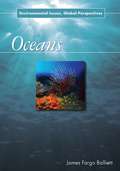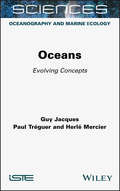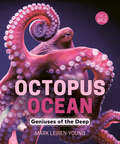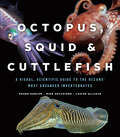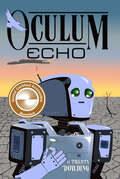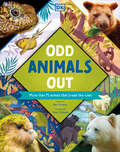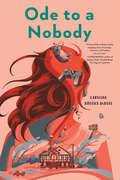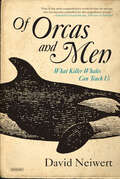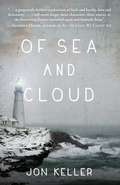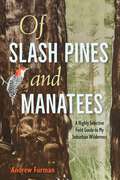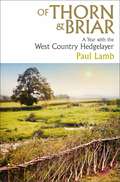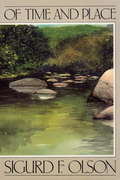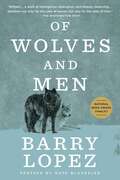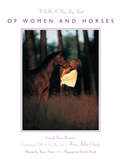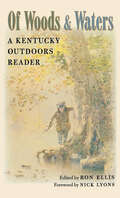- Table View
- List View
Oceans: Environmental Issues, Global Perspectives
by James Fargo BalliettCovering 71 percent of the planet, these saline bodies of water provided the unique conditions necessary for the building blocks of life to form billions of years ago. This book explains how our oceans continue to support and influence life in important ways: by providing the largest global source of protein in the form of fish populations, by creating and influencing weather systems, and by absorbing waste streams such as airborne carbon. It is shown how oceans have an almost magnetic draw—almost half of the world’s population lives within a few hours of an ocean. Although oceans are vast in size, exceeding 328 million cubic miles (1.37 billion cubic kilometers), they have been influenced by and have influenced humans in numerous ways. The book includes three detailed case studies. The first focuses on the most remote locations along the Mid-Atlantic Ridge, where new ocean floor is being formed twenty-thousand feet underwater. The second considers the Maldives, a string of islands in the Indian Ocean, where increasing sea levels may force residents to abandon some communities by 2020. The third describes the North Sea at the edge of the Arctic Ocean, where fishing stocks have been dangerously depleted as a result of multiple nations’ unrelenting removal of the smallest and largest species.
Oceans: Evolving Concepts (Ioc Ocean Forum Ser.)
by Guy Jacques Paul Tréguer Herlé MercierSince the HMS Challenger expedition of 1872–1876, our vision of the ocean has changed completely. We now understand that it plays a key role in biodiversity, climate regulation, and mineral and biological resources, and as such, the ocean is a major service provider for humanity. Oceans draws on data from new oceanographic and satellite tools, acquired through international interdisciplinary programs. It describes the processes that control how the ocean functions, on different spatial and temporal scales. After considering the evolution of concepts in physical, chemical and biological oceanography, the book outlines the future of a warmer, acidified, less oxygenated ocean. It shows how a view of the ocean at different scales changes how we understand it. Finally, the book presents the challenges facing the ocean in terms of the exploitation of biological and mineral resources, in the context of sustainable development and the regulation of climate change.
Octo-Activity Book (Octonauts Above & Beyond #99)
by Official OctonautsThe Octonauts are on a global mission - on land! Enlisting their intrepid friends from around the world as Octo-agents - and equipped with a new fleet of land-based Terra Gups - the Octonauts' work is as vital as ever. They explore far-flung environments, rescue animals that need their help and protect the land and all living creatures.Featuring everyone's favourites from the original series, such as Captain Barnacles and Kwazii Cat, OCTONAUTS ABOVE & BEYOND introduces lovable characters like Paani, the water scientist monkey as they learn all about new environments, endangered animals, protecting habitats and more.Did you know...?- Bearded dragons are equipped with armour of spiny reptilian scales, which include a "beard" of spikes under its chin that puffs up depending on its mood.- Most crabs live in the ocean, but desert crabs live in tunnels under the ground and only come out at night when it's cool.- Antarctica is a cold desert that gets little snow and even less rain.The Octo-Report Fact and Activity Book is full of information about the amazing creatures and habitats featured in the episodes, and includes fun puzzles, mazes, games and activities pertaining to them.
October, or Autumnal Tints
by Henry D. Thoreau Robert D. Richardson Lincoln Perry"A gorgeous edition" (Boston Globe) of Thoreau's classic work, enhanced with an illuminating essay and beautiful watercolors. Originally delivered as a lecture shortly before the writer's own death, Henry David Thoreau's classic "Autumnal Tints" is an ode to autumn not as the season of death and decay, but of ripeness, fullness, and maturity. It is perhaps the best piece ever written on the subject of the fall color of the changing leaves. Thoreau hoped one day to turn it into an illustrated book called "October, or Autumnal Tints." Thoreau's astute meditations are framed by a biographical essay by acclaimed scholar Robert D. Richardson that delves into the events and relationships influencing Thoreau's philosophy. Sensuous watercolors by Lincoln Perry bring to life the fall colors described so ecstatically by Thoreau, allowing longtime Thoreau fans and leaf-peepers alike to feel as though they are walking among the falling leaves alongside one of our best observers of the natural world.
October, or Autumnal Tints
by Henry David Thoreau(From the Dust Jacket Flaps) "Originally delivered as a lecture shortly before the writer's own death, Henry David Thoreau's classic Autumnal Tints is an ode to autumn not as the season of death and decay, but of ripeness, fullness, and maturity. It is perhaps the best piece ever written on the subject of the fall color of the changing leaves. Thoreau hoped one day to turn it into an illustrated book called October, or Autumnal Tints. Thoreau's astute meditations are framed by a biographical essay by acclaimed scholar Robert D. Richardson that delves into the events and relationships influencing Thoreau's philosophy. Sensuous watercolors by Lincoln Perry bring to life the fall colors described so ecstatically by Thoreau, allowing longtime Thoreau fans and leaf-peepers alike to feel as though they are walking among the falling leaves alongside one of our best observers of the natural world."
Octopus
by Patrick WarnerAs apt to channel the confessionalism of Anne Sexton as the red-in-tooth-and-claw nature poetry of Ted Hughes, Patrick Warner's voice ranges freely from the colloquial to the baroque. Over the past fifteen years, by harboring and honoring such fraught tensions. In Octopus we have him at his best.
Octopus Ocean: Geniuses of the Deep (Orca Wild)
by Mark Leiren-Young★“Vivid and fascinating...Budding scientists and animal lovers will keep this stellar title in full-circulation as they learn the mysteries and history of octopuses.”—School Library Journal, starred review With their blue blood, big brains and eight arms, octopuses are dramatically different from any other being. Octopuses are masters of camouflage and known for their incredible escapes from tight spots. New research shows that they are highly intelligent creatures, and while they prefer to be alone, they will interact with humans and display unique personality traits. In Octopus Ocean, discover the mysteries and histories of octopuses big and small—their biology, habitat and habits—and explore the top threats to their future, including warming oceans, over-fishing and pollution. The epub edition of this title is fully accessible.
Octopus, Squid & Cuttlefish: A Visual, Scientific Guide to the Oceans' Most Advanced Invertebrates
by Roger Hanlon Louise Allcock Michael Vecchione“Cephalopods are often misunderstood creatures. Three biologists set the record straight on the behaviors and evolution of these invertebrates of the sea.” —Science NewsLargely shell-less relatives of clams and snails, the marine mollusks in the class Cephalopoda—Greek for “head-foot” —are colorful creatures of many-armed dexterity, often inky self-defense, and highly evolved cognition. They are capable of learning, of retaining information—and of rapid decision-making to avoid predators and find prey. They have eyes and senses rivaling those of vertebrates like birds and fishes, they morph texture and body shape, and they change color faster than a chameleon. In short, they captivate us.From the long-armed mimic octopus—able to imitate the appearance of swimming flounders and soles—to the aptly named flamboyant cuttlefish, whose undulating waves of color rival the graphic displays of any LCD screen, there are more than seven hundred species of cephalopod. Featuring a selection of species profiles, Octopus, Squid, and Cuttlefish reveals the evolution, anatomy, life history, behaviors, and relationships of these spellbinding animals. Their existence proves that intelligence can develop in very different ways: not only are cephalopods unusually large-brained invertebrates, they also carry two-thirds of their neurons in their arms. A treasure trove of scientific fact and visual explanation, this worldwide illustrated guide to cephalopods offers a comprehensive review of these fascinating and mysterious underwater invertebrates—from the lone hunting of the octopus, to the social squid, and the prismatic skin signaling of the cuttlefish.“After reading about the cephalopods’ abilities and behaviors, as well as their potential for advancing our lives, readers might think twice before ordering their next calamari appetizer.” —American Scientist
Octopus: The Ocean's Intelligent Invertebrate
by James B. Wood Roland C. Anderson Jennifer A. MatherThe visually arresting and often misunderstood octopus has long captured popular imagination. With an alien appearance and an uncanny intellect, this exceptional sea creature has inspired fear in famous lore and legends—from the giant octopus attack in 20,000 Leagues Under the Sea to Ursula the sea witch in The Little Mermaid. Yet its true nature is more wondrous still. After decades of research, the authors reveal a sensitive, curious, and playful animal with remarkable intelligence, an ability to defend itself with camouflage and jet propulsion, an intricate nervous system, and advanced problem-solving abilities. In this beautifully photographed book, three leading marine biologists bring readers face to face with these amazingly complex animals that have fascinated scientists for decades. From the molluscan ancestry of today’s octopus to its ingenious anatomy, amazing mating and predatory behaviors, and other-worldly relatives, the authors take readers through the astounding life cycle, uncovering the details of distinctive octopus personalities. With personal narratives, underwater research, stunning closeup photography, and thoughtful guidance for keeping octopuses in captivity, Octopus is the first comprehensive natural history of this smart denizen of the sea.
Oculum Echo (The Children of Oculum #2)
by Philippa DowdingThe explosions come in the night. Miranda1, Mannfred, Grannie, and the one thousand children of Oculum must flee their farm, chased by the UnRuly. But there is hope: an old friend sends word of a book that may hold the secret to their survival. Just as they begin their journey through the wasteland, Echo1 wakes from an eighty-three-year sleep and is given a mission to find the four domes of the children of Oculum, and to find the First One, whatever the cost.
Odd Animals Out (Wonders of Wildlife )
by Ben HoareMost types of animals are similar to their close relatives, but what about the rebels and the rule-breakers of the animal kingdom? Discover more than 75 creatures that truly stand out from the crowd, with the nature enthusiast and bestselling author Ben Hoare.From a vegetarian shark and a solar-powered salamander to a flying frog and a bone-munching bird, this book is all about the "odd ones out" in the natural world. Get acquainted with quirky animal outliers around the world and find out what these nonconformists do to survive in the wild, and how they have evolved over time. Presenting these recent discoveries, Ben Hoare's friendly, informative explanations are paired with stunning photographs and charming illustrations to make sure every page captivates the imagination.Odd Animals Out is a book full of surprises, allowing you to explore the unusual stories of animals unlike any others.
Ode to a Nobody
by Caroline Brooks DuBoisA devastating tornado tears apart more than just houses in this striking novel in verse about a girl rebuilding herself.Before the storm, thirteen-year-old Quinn was happy flying under the radar. She was average. Unremarkable. Always looking for an escape from her house, where her bickering parents fawned over her genius big brother. Inside our broken home / we didn&’t know how broken / the world outside was. But after the storm, Quinn can&’t seem to go back to average. Her friends weren't affected by the tornado in the same way. To them, the storm left behind a playground of abandoned houses and distracted adults. As Quinn struggles to find stability in the tornado&’s aftermath, she must choose: between homes, friendships, and versions of herself. Nothing that was mine / yesterday is mine today. Told in rich, spectacular verse, Caroline Brooks DuBois crafts a powerful story of redemption as Quinn makes her way from Before to After. There&’s nothing average about the world Quinn wakes up to after the storm; maybe there&’s nothing average about her, either. This emotional coming-of-age journey for middle grade readers proves that it&’s never too late to be the person you want to be.
Odyssey: Young Charles Darwin, The Beagle, and The Voyage that Changed the World
by Tom ChaffinAn illuminating and lively narrative of Charles Darwin&’s formative years and adventurous voyage aboard the H.M.S. Beagle.Charles Darwin—alongside Isaac Newton and Albert Einstein—ranks among the world's most famous scientists. In popular imagination, he peers at us from behind a bushy white Old Testament beard. This image of Darwin the Sage, however, crowds out the vital younger man whose curiosities, risk-taking, and travels aboard HMS Beagle would shape his later theories and served as the foundation of his scientific breakthroughs. Though storied, the Beagle's voyage is frequently misunderstood, its mission and geographical breadth unacknowledged. The voyage's activities associated with South America—particularly its stop in the Galapagos archipelago, off Ecuador&’s coast—eclipse the fact that the Beagle, sailing in Atlantic, Pacific and Indian ocean waters, also circumnavigated the globe. Mere happenstance placed Darwin aboard the Beagle—an invitation to sail as a conversation companion on natural-history topics for the ship's depression-prone captain. Darwin was only twenty-two years old, an unproven, unknown, aspiring geologist when the ship embarked on what stretched into its five-year voyage. Moreover, conducting marine surveys of distance ports and coasts, the Beagle's purposes were only inadvertently scientific. And with no formal shipboard duties or rank, Darwin, after arranging to meet the Beagle at another port, often left the ship to conduct overland excursions. Those outings, lasting weeks, even months, took him across mountains, pampas, rainforests, and deserts. An expert horseman and marksman, he won the admiration of gauchos he encountered along the way. Yet another rarely acknowledged aspect of Darwin's Beagle travels, he also visited, often lingered in, cities—including Rio de Janeiro, Buenos Aires, Montevideo, Santiago, Lima, Sydney, and Cape Town; and left colorful, often sharply opinionated, descriptions of them and his interactions with their residents. In the end, Darwin spent three-fifths of his five-year "voyage" on land—three years and three months on terra firma versus a total 533 days on water. Acclaimed historian Tom Chaffin reveals young Darwin in all his complexities—the brashness that came from his privileged background, the Faustian bargain he made with Argentina's notorious caudillo Juan Manuel de Rosas, his abhorrence of slavery, and his ambition to carve himself a place amongst his era's celebrated travelers and intellectual giants. Drawing on a rich array of sources— in a telling of an epic story that surpasses in breadth and intimacy the naturalist's own Voyage of the Beagle—Chaffin brings Darwin's odyssey to vivid life.
Of Orcas and Men: What Killer Whales Can Teach Us
by David NeiwertA journalist &“convincingly spells out the threats to their survival, their misery in captivity, and what scientists can learn by studying them&” (Kirkus). The orca—otherwise known as the killer whale—is one of earth&’s most intelligent animals. Remarkably sophisticated, orcas have languages and cultures and even long-term memories, and their capacity for echolocation is nothing short of a sixth sense. They are also benign and gentle, which makes the story of the captive-orca industry—and the endangerment of their population in Puget Sound—that much more damning. In Of Orcas and Men, a marvelously compelling mix of cultural history, environmental reporting, and scientific research, David Neiwert explores an extraordinary species and its occasionally fraught relationship with human beings. Beginning with their role in myth and contemporary culture, Neiwert shows how killer whales came to capture our imaginations, and brings to life the often catastrophic environmental consequences of that appeal. In the tradition of Barry Lopez&’s classic Of Wolves and Men, David Neiwert&’s book is a triumph of reporting, observation, and research, and a powerful tribute to one of the animal kingdom&’s most remarkable members.Praise for Of Orcas and Men &“Human beings need to learn from and understand the cooperative nature of orca society. Everyone who is interested in both animal and human behavior should read this remarkable book.&” —Temple Grandin, New York Times–bestselling author of Animals in Translation and Animals Make Us Human &“Powerful and beautifully written.&” —Jane Goodall &“Humans and killer whales have a long and complicated history, one that David Neiwert describes forcefully and eloquently in this fascinating and highly readable book.&” —David Kirby, New York Times–bestselling author of Death at SeaWorld &“[A] breathtaking survey of orca science, folklore, and mystery.&” —The Stranger
Of Sea and Cloud
by Jon KellerNicolas Graves raised his sons to be lobstermen. Bill and Joshua (known as Jonah) Graves grew up aboard their father's boat--the Cinderella--learning the rules and rites of the antiquated business they love. But when their father is lost at sea and the price of lobster crashes worldwide, Bill and Jonah must decide how much they are willing to risk for their family legacy. Standing against them is Osmond Raymond--former Calvinist minister, mystic, captain of the Sanctity, and their father's business partner for more than twenty years. Together with his grandson and heir, Julius, Osmond is determined to push the Graves family out of their lobster pound, regardless of the cost or the consequences. Praise for Of Sea and Cloud "A gorgeously written exploration of faith and loyalty, love and dishonesty... I will never forget these characters, these waters, or the harrowing dramas unfolded upon and beneath them." --Anthony Doerr, author of All The Light We Cannot See "Exquisitely well-written, relentlessly compelling, this story of fathers and sons and lovers, of love and greed and betrayal, elevates the desperate lives of lobstermen into Shakespearean tragedy. This novel set its hooks quickly, and held me rapt until the brutal, beautiful, end. Of Sea and Cloud is timeless drama of the highest order, both thrilling and wise, and Jon Keller is an extraordinary new voice in fiction." --Alan Heathcock, award-winning author of Volt "...dark, poetic, and at turns terrifying. Set against the harsh Maine coast, it tells the story of a people inextricably connected to their land, and of what happens when that land is threatened. Ultimately, this is a novel about love in all its forms and failures." --Abi Maxwell, author of Lake People "A bleak and beautiful story of a family of fog-shrouded lobstermen caught in the heavy vice of change, told in a voice that is part Dennis Lehane, part Melville, part Homer, and all Jon Keller. The book's dark mystic, Osmond Randolph, will haunt me for weeks to come." --Christian Kiefer, author of The Infinite Tides "Of Sea and Cloud is a remarkable read, a first novel that captures a blood and breath drama that is both gripping and evocative." --Debra Magpie Earling, author of Perma Red "With measured and powerful prose, Jon Keller writes a timeless story of manhood, loss, and the bonds of family." --Chris Offutt, author of No Heroes: A Memoir of Coming Home "...a bone-chilling story of brotherhood, trust, and betrayal. It belongs in the canon of great American maritime novels alongside Hemingway and Melville." --Tyler McMahon, author of How the Mistakes Were Made and Kilometer 99
Of Slash Pines and Manatees: A Highly Selective Field Guide to My Suburban Wilderness (Co-published with Florida Humanities)
by Andrew FurmanThrough stories of nature near at hand, Andrew Furman explores touchpoints between his everyday suburban life and the environment in South Florida, contemplating his place in a subtropical landscape stretching from the Everglades to the Atlantic coast.
Of Summits and Sacrifice
by Thomas BesomIn perhaps as few as one hundred years, the Inka Empire became the largest state ever formed by a native people anywhere in the Americas, dominating the western coast of South America by the early sixteenth century. Because the Inkas had no system of writing, it was left to Spanish and semi-indigenous authors to record the details of the religious rituals that the Inkas believed were vital for consolidating their conquests. Synthesizing these arresting accounts that span three centuries, Thomas Besom presents a wealth of descriptive data on the Inka practices of human sacrifice and mountain worship, supplemented by archaeological evidence. Of Summits and Sacrifice offers insight into the symbolic connections between landscape and life that underlay Inka religious beliefs. In vivid prose, Besom links significant details, ranging from the reasons for cyclical sacrificial rites to the varieties of mountain deities, producing a uniquely powerful cultural history.
Of Thorn & Briar: A Year with the West Country Hedgelayer
by Paul Lamb&‘This spare but elegant account is an unexpected delight, and as soothing as a walk down a tree-dappled lane at sunset&’ – Daily Mail&‘Gentle and timeless, Paul is the authentic voice of the countryside. This is the story of a man at one with the land.&’ – Lara Maiklem, author of Mudlarking Paul Lamb is a hedgelayer. From the end of summer until the birds nest in the spring, he maintains the ancient boundaries of the British countryside. He lives in his wagon, as many itinerant farm workers used to, and travels the south-west corner of England, restoring an important but often forgotten part of our country. Hedgerows are a living structure, woven into the fabric of rural life, a vital aspect of man&’s partnership with nature. As traditional management techniques are lost to modernisation, hedges have declined dramatically. Paul works alone and by hand to rejuvenate these linear woodlands, saving the homes of the wildlife that rely on them and bringing many other ecological benefits. Following the rhythm of the seasons, Of Thorn & Briar describes Paul&’s life on the road and the practical aspects of his job. It is about practising a craft with skill, preserving our heritage for future generations and celebrating the glory of the landscape he&’s spent his life caring for.
Of Tigers and Men
by Richard IvesChronicles the author's four-year search for the wild tiger that followed his discovery that tigers were being driven toward extinction, and describes the world he saw and his desire to meet a tiger unarmed and face-to-face.
Of Time and Place
by Sigurd F. OlsonOf Time and Place is a legacy from one of the best-loved nature writers of our time. In this, his last book, completed just before his death, Sigurd F. Olson guides readers through his wide-ranging memories of a lifetime dedicated to the preservation of the wilderness. Like his other best-selling books, Of Time and Place is filled with beauty, adventure, and wonder. Olson recalls his many friendships of trail and woods and portage, his favorite campsites, the stories behind the artifacts and mementos hanging in his cabin at Listening Point. Whether he is remembering canoe trips with his friends, admiring the playful grace of the otter, or pondering the Earth's great cycles of climatic change, these moving and evocative essays reaffirm Olson's stature as one of the greatest nature writers of this century.
Of Wolves and Men
by Barry LopezOriginally published in 1978, this classic exploration of humanity&’s complex relationship with and understanding of wolves returns with a new afterword by the author.Humankind's relationship with the wolf is the sum of a spectrum of responses ranging from fear to admiration and affection. Lopez&’s classic, careful study has won praise from a wide range of reviewers and improved the way books on wild animals are written. Of Wolves and Men explores the uneasy interaction between wolves and civilization over the centuries, and the wolf's prominence in our thoughts about wild creatures. Drawing upon an impressive array of literature, history, science, and mythology as well as extensive personal experience with captive and free-ranging wolves, Lopez argues for the wolf's preservation and immerses the reader in its sensory world, creating a compelling portrait of the wolf both as a real animal and as imagined by different kinds of men. A scientist might perceive the wolf as defined by research data, while an Eskimo hunter sees a family provider much like himself. For many Native Americans the wolf is also a spiritual symbol, a respected animal that can strengthen the individual and the community. With irresistible charm and elegance, Of Wolves and Men celebrates careful scientific fieldwork, dispels folklore that has enabled the Western mind to demonize wolves, explains myths, and honors indigenous traditions, allowing us to understand how this remarkable animal has become so prominent for so long in the human heart.
Of Women And Horses: Vol 2
by Gawani Pony Boy Mark J. BarrettIn the tradition of "Horse Follow Closely", GaWaNi Pony Boy gathers an impressive array of known and unknown horsewomen, who, in touching prose, describe the unique relationships they have with their horses.<P> GaWaNi Pony Boy's unique approach to horses is captured in these five books from BowTie Press. GaWaNi Pony Boy is the founder and president of lyuptala University (lyuptala means "one-with" in Lakota), and online college that allows horse lovers to expand their knowledge of these magnificent animals. He regularly writes for equine publications throughout the United States and Europe.
Of Women and Horses: Essays by Various Horse Women
by Gawani Pony Boy Gabrielle BoiselleA survey of horsewomen introduces women from all walks of life as they explore their love of horses.<P> GaWaNi Pony Boy's unique approach to horses is captured in these five books from BowTie Press. GaWaNi Pony Boy is the founder and president of lyuptala University (lyuptala means "one-with" in Lakota), and online college that allows horse lovers to expand their knowledge of these magnificent animals. He regularly writes for equine publications throughout the United States and Europe.
Of Woodland Pools, Spring-Holes and Ditches: Excerpts from the Journal of Henry David Thoreau
by Henry David Thoreau Abigail Rorer Bradley P. DeanHenry David Thoreau has long been revered for his writings and observations on the natural world. His words evoke his environment with stunning clarity as well as his own innate sense of wonder. His journal, from which the text of Of Woodland Pools, Spring-Holes and Ditches is drawn, shares these strengths, providing an intimate view of Thoreau's day-to-day existence.The selected excerpts are pulled from the months of March, April, and May, and all pertain to what are now called vernal pools - temporary pools of water, free of fish, at their peak in the spring, and the breeding ground for numerous creatures.In this volume, Thoreau's words are accompanied by 28 engravings by artist Abigail Rorer. The delicacy and detail of these engravings make them the perfect companion to Thoreau's words, adding another layer of beauty to his observations. Each engraving is a work of art in and of itself, enriched by the text and Thoreau's visionary descriptions. The engravings are based on the woods and vernal pools explored by Thoreau, lending them undeniable authenticity.Thoreau once proclaimed, "I have an appointment with spring." Through his words and Rorer's art, so too does the reader.
Of Woods & Waters: A Kentucky Outdoors Reader
by Ron Ellis Nick Lyons“An insightful and varied view of Kentucky’s lush landscape. . . . [Will] appeal to hunters, anglers, environmentalists.” —Kentucky MonthlyFrom the moment Daniel Boone first “gained the summit of a commanding ridge, and . . . beheld the ample plains, the beauteous tracts below,” generations of Kentuckians have developed rich and enduring relationships with the land that surrounds them. Of Woods & Waters: A Kentucky Outdoors Reader is filled with loving tributes offered in celebration of Kentucky’s widely varied environmental wonders that nurture both life and art.Ron Ellis, an outdoors enthusiast and noted writer, has gathered art, fiction, personal essays and poetry from many of Kentucky’s best-known authors for this comprehensive collection. Beginning with famed illustrator John James Audubon’s eloquent account of extracting catfish from the Ohio River and progressing through over fifty contributions by both established and emerging writers, Of Woods & Water covering two hundred years of hunting, fishing, camping, cooking, hiking, and canoeing in Kentucky’s wilderness.With contributions from Barbara Kingsolver, Wendell Berry, Janice Holt Giles, Bobbie Ann Mason, Jesse Stuart, James Still, Robert Penn Warren, James Baker Hall, Silas House, and other esteemed authors.“No other state offers such a variety of topics for its writers and this [anthology], which incorporates love of the land and the love of nature, is special.” —James C. Claypool, Northern Kentucky University, author of Our Fellow Kentuckians“Takes your mind outside. Read enough of it and you might get out of the chair and follow.” —Lexington Herald-Leader“A superb collection.” —Louisville Courier-Journal“Reading Of Woods & Waters is a sensory experience. Its fine, down-home musings stay with you long after the last page is turned.” —Murray Ledger and Times
